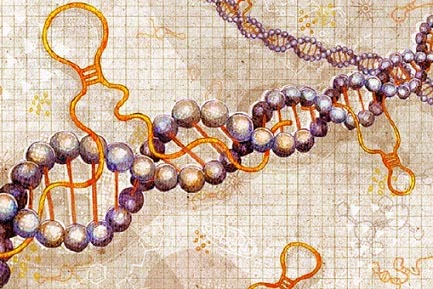Cutting-edge research reveals non-coding RNAs' role in tissue repair and fibrosis
Nikhil Prasad Fact checked by:Thailand Medical News Team Jul 25, 2024 8 months, 2 weeks, 5 days, 19 hours, 40 minutes ago
Medical News: Fibrosis, a condition characterized by the thickening and scarring of connective tissue, is a common aftermath of chronic injury and disease. Groundbreaking research led by scientists from Tianjin First Central Hospital in China and the Hospital for Special Surgery in New York, USA, has unveiled how non-coding RNAs (ncRNAs) orchestrate the transformation of fibroblasts into myofibroblasts - a critical process in tissue repair and fibrotic diseases. This
Medical News report delves into the intricate roles of these ncRNAs and their potential as therapeutic targets.
 Cutting-edge research reveals non-coding RNAs' role in tissue repair and fibrosis
What are Non-Coding RNAs?
Cutting-edge research reveals non-coding RNAs' role in tissue repair and fibrosis
What are Non-Coding RNAs?
Non-coding RNAs are RNA molecules that do not translate into proteins but play crucial roles in regulating gene expression. Among these, microRNAs (miRNAs), long non-coding RNAs (lncRNAs), and circular RNAs (circRNAs) stand out for their significant impact on cellular functions.
Fibroblast to Myofibroblast Transition (FMT): The Basics
Fibroblasts are cells that produce collagen and other extracellular matrix components, essential for tissue repair. When tissues are injured, fibroblasts transform into myofibroblasts, a process marked by increased collagen production and tissue remodeling. While this transition is vital for healing, excessive myofibroblast activity leads to fibrosis, contributing to diseases like pulmonary fibrosis, liver cirrhosis, and heart disease.
MicroRNAs: The Fine-Tuners
MiRNAs, small RNA molecules about 22 nucleotides long, regulate gene expression by binding to target messenger RNAs (mRNAs), inhibiting their function. In FMT, certain miRNAs act as promoters, while others serve as inhibitors.
Promoters of FMT
MiR-21 is a prominent miRNA that drives FMT by enhancing fibroblast responsiveness to the Transforming Growth Factor-beta (TGF-β) signaling pathway. This leads to increased collagen production and myofibroblast differentiation. Other miRNAs, such as miR-146b and miR-125b, also promote FMT by targeting molecules that inhibit myofibroblast activation.
Inhibitors of FMT
Conversely, miR-29 and miR-200 families are known to suppress FMT. These miRNAs target genes involved in collagen synthesis, preventing excessive extracellular matrix deposition and fibrosis. By maintaining a balance between these promoting and inhibiting miRNAs, tissue homeostasis is preserved.
Long Non-Coding RNAs: The Orchestrators
LncRNAs, RNA molecules longer than 200 nucleotides, do not code for proteins but regulate gene expression at multiple levels, including chromatin remodeling, transcription, and post-transcriptional processing.
LncRNAs Promoting FMT
Notable lncRNAs like H19X and GAS5 play critical roles in FMT. H19X, for example, interacts with chromatin modifiers an
d transcription factors to drive the gene expression changes necessary for myofibroblast differentiation. GAS5, on the other hand, suppresses TGF-β signaling, thus inhibiting fibrosis.
LncRNAs Inhibiting FMT
Certain lncRNAs act as inhibitors of fibrosis. For instance, the lncRNA PFI inhibits myofibroblast activation and promotes tissue equilibrium. By targeting these lncRNAs, it is possible to modulate fibroblast activity and potentially treat fibrotic diseases.
Circular RNAs: The Sponges
CircRNAs are a unique class of ncRNAs that form covalently closed loop structures, making them highly stable. They primarily function by sequestering miRNAs, thus preventing them from interacting with their target mRNAs.
CircRNAs in Action
CircHIPK3 is a circRNA that sponges miR-338-3p, freeing the miRNA’s target genes, such as SOX4 and COL1A1, from inhibition. This activity promotes fibroblast activation and myofibroblast differentiation, highlighting circRNAs' role in fibrosis.
CircRNAs and Protein Interactions
Beyond miRNA sponging, circRNAs also interact with RNA-binding proteins to influence gene expression. For instance, Circ-sh3rf3 interacts with GATA-4 proteins, affecting miR-29a expression and inhibiting myocardial fibrosis.
Implications for Therapy
The discovery of ncRNAs' roles in FMT opens new avenues for therapeutic interventions in fibrotic diseases. Strategies targeting these ncRNAs could finely tune the balance between fibroblast quiescence and myofibroblast activation, offering hope for treating fibrosis.
MiRNA-Based Therapies
Therapies involving miRNAs include mimics to restore the function of downregulated miRNAs or antagonists to inhibit the function of upregulated miRNAs. For instance, miR-29 mimics have shown promise in reducing fibrosis by targeting collagen synthesis.
LncRNA-Based Therapies
Targeting pro-fibrotic lncRNAs or boosting anti-fibrotic lncRNAs can modulate gene expression profiles involved in fibrosis. Gene therapy approaches and small molecules enhancing the expression of beneficial lncRNAs are being explored.
CircRNA-Based Therapies
CircRNA-based therapies focus on designing synthetic circRNA sponges or modulating circRNA-protein interactions to influence gene expression patterns involved in fibrosis.
Challenges and Future Directions
While ncRNA-based therapies hold promise, challenges such as efficient delivery, specificity, and potential off-target effects need to be addressed. Advancements in delivery systems, such as nanoparticle-mediated delivery and tissue-specific liposomes, are being explored to overcome these hurdles.
Future research will likely focus on combination therapies, personalized medicine approaches, and robust translational efforts to bring ncRNA-based therapies from bench to bedside. By understanding the complex regulatory networks involving ncRNAs, we can develop precise treatments for fibrotic diseases, ultimately improving patient outcomes.
Conclusion
The study findings underscore the significant roles of ncRNAs in the fibroblast to myofibroblast transition and fibrotic diseases. By deciphering these intricate molecular mechanisms, we pave the way for innovative therapeutic strategies that could mitigate fibrosis and restore tissue health.
The study findings were published in the peer-reviewed journal Frontiers in Pharmacology.
https://www.frontiersin.org/journals/pharmacology/articles/10.3389/fphar.2024.1423045/full
For the latest on Fibrosis research, keep on logging to Thailand
Medical News.
Read Also:
https://www.thailandmedical.news/news/the-uniqueness-of-post-covid-lung-fibrosis-the-increased-expression-of-atp12a-protein
https://www.thailandmedical.news/news/long-term-lung-healing-even-after-mild-or-moderate-covid-19-many-could-develop-lung-fibrosis
